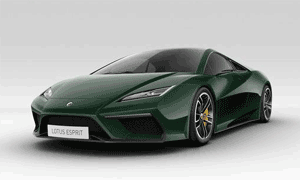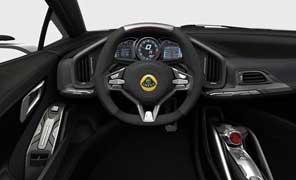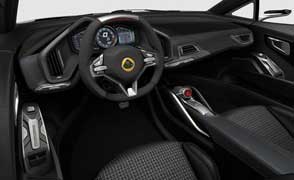

2014 Lotus Esprit
Car & Driver, September 2010
New Lotus CEO Dany Bahar—who previously was senior VP for brand management at Ferrari—has a pretty grandiose plan for the small English sports-car maker, moving it upscale from the Elise, Exige, and Evora to a range squarely aimed at Porsche. Among the new Elan, Elise, Elite, and Eterne, the apex predator will be the mid-engine Esprit supercar, which revives the moniker used on the Giugiaro-designed two-seat wedge that went on sale in 1976. The new car is scheduled to appear in 2013 as a 2014 model.
Toyota Power, With Optional Hybrid Technology
Just like the last Esprit, which was sold with a 3.5-liter twin-turbo V-8 engine from 1996 to 2004, the new car has a bent-eight mounted amidships. But, whereas the old engine was developed in-house, this car uses a 5.0-liter V-8 sourced from the Lexus IS F, and then turbocharged. Lotus must have done a bit more than just slap on the turbo, as the engine spins up to 8500 rpm (the IS F’s unit redlines at 6800). The company claims output of 612 hp and a stout 531 lb-ft of torque.The car drives the rear wheels via a seven-speed dual-clutch transmission. Intriguingly, Lotus says that the car will be available with a hybrid option, using a Kinetic Energy Recovery System (KERS) like those seen in Formula 1 in 2009 and due to be reintroduced for the 2011 season.
The Esprit is 179.1 inches long, 76.8 inches wide, and 49.2 inches high, almost spot on with the Ferrari 458 Italia’s dimensions. Lotus claims that it will weigh 3197 pounds—somewhat lighter than the Ferrari—enabling it to sprint from 0 to 62 mph in 3.4 seconds and go on to a top speed of 205 mph. The price is estimated to be in the region of $110,000, far less than the 458 Italia or an Aston Martin V-12 Vantage. That price tag will leave Lotus loyalists with a very difficult decision to make: 612-hp, front-engine Elite for about $115,000; or 612-hp, mid-engine Esprit for nearly the same price.
Haven’t We Been Here Before?
The last time Lotus headed upscale was when company founder Colin Chapman was in charge. Lotus had been making the fabulous Elan roadster and coupe through the 1960s, but Chapman decided he needed to make more money from his cars, and introduced the Elite 2+2 coupe in 1974. He followed that up with the Eclat and the original Esprit. Lotus lurched though the next two decades and only started selling vehicles in any reasonable volumes with the launch of the Elise in 1996.While Lotus has always been able to produce a great chassis, elements like the fit and finish (and reliability) have always been lacking, especially compared with Porsche’s efforts. It was the case in the 1970s and it’s the same today when you compare the Evora with cars like the Porsche 911 and Cayman S. If Bahar is serious about moving Lotus upscale, it’s not historical names and humongous horsepower that will determine its success, but the build quality of its products. Well, we suppose a 612-hp, 8500-rpm V-8 can’t hurt.














|
|